Malva, Mallow
Khubbazi (Unani)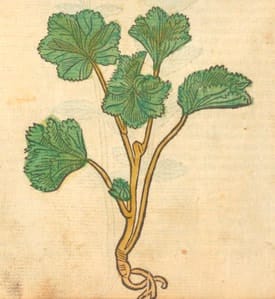 Gart der Gesundheit, Cuba, 1485
Gart der Gesundheit, Cuba, 1485
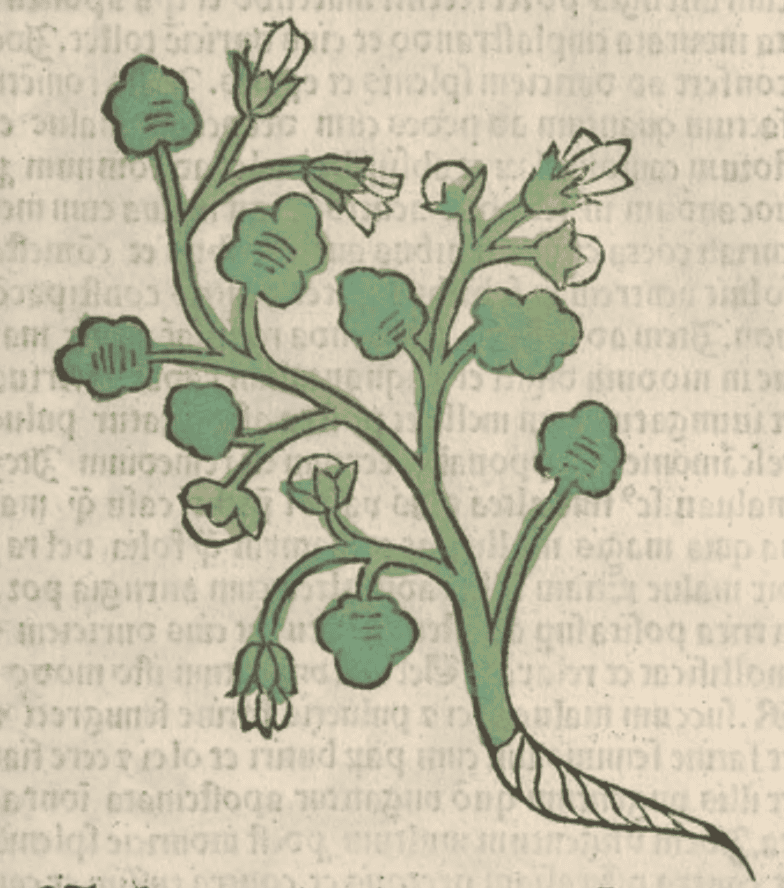 Herbarius latinus, Petri, 1485
Herbarius latinus, Petri, 1485 |
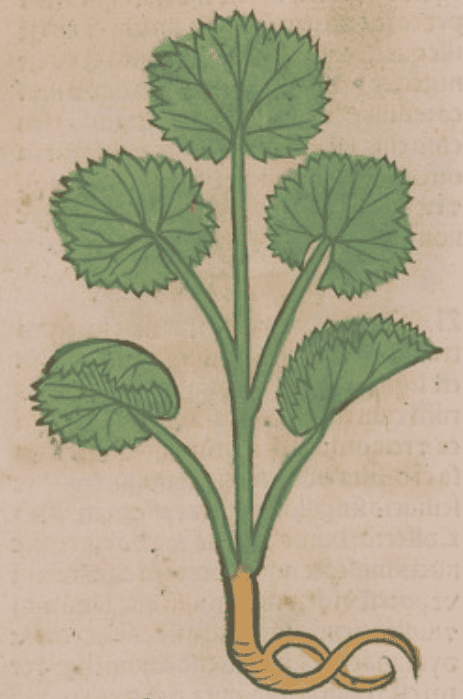 Ortus Sanitatis, Meydenbach, 1491
Ortus Sanitatis, Meydenbach, 1491 |
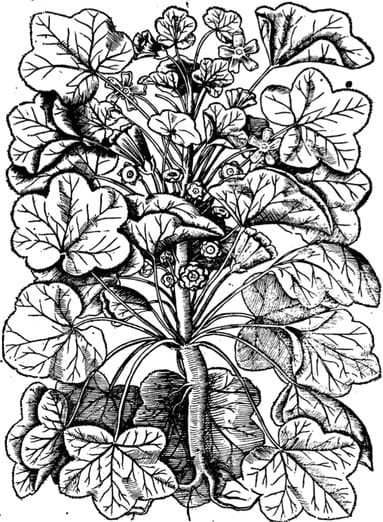 New Kreuterbuch, Matthiolus, 1563
New Kreuterbuch, Matthiolus, 1563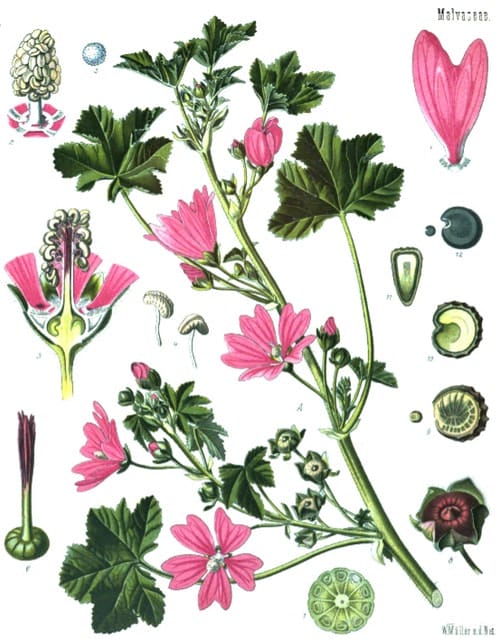 Malva sylvestris
Malva sylvestrisKoehler’s Medizinal Pflanzen, 1887

|

|
Flora von Deutschland (21), Kohler, 1885
 1. Malva sylvestris; 2 M. rotundifolia
1. Malva sylvestris; 2 M. rotundifolia3. M. rotundifolia var. pusilla; 4. M. moschata
Florigraphia Britannica, Deakin, 1857
Botanical name:
Malva sylvestris (syn. M. vulgaris)
A number of related Malva species are used similarly:
- Musk Mallow (M. verticillata syn. M. moschata, M. pulchella) is used the same, but is weaker
- M. neglecta (Dwarf Mallow) is also used, and is said to be stronger.
- M. rotundifolia (Low Mallow)
Parts used:
Leaf, flower,, Root
See also Mallow Seed
Temperature & Taste:
Cool, moist. Sweet. Leaf is Warmer, Seed is more Moist.
‘The Seed and Root have the same vertues’. (Schroder)
Classifications:
2A APERIENT. 2E LENITIVE. 2J. RAREFYING. 2L. EMOLLIENT. 2Q. ANODYNE. 2T. GLUTINATE. 2U. SUPPURATIVE
3H. LACTAGOGUE. 3K. EXPECTORANT. 3L. ANTI-TUSSIVE. 3M. ARTHRITICS.
4d. PECTORAL. 4f. SPLENETIC. 4h. NEPHRITIC
Preparers and Purgers of Bile
TCM:
C. Clear Damp, Promote Urine
Uses:
1. Clears Heat, Soothes the Stomach and Bowels:
-gnawing pain, Ulcers and corrosion of the Stomach and Bowels
-Loosens the Belly, benefits the Bowels, good for corrosion of them, eases Pain
–seed is used for Constipation from dryness of the Bowels
2. Clears Heat, Moistens the Lungs, Stops Cough:
-benefits the Lungs
-Cough, Bronchitis, Hoarseness, Consumption
3. Clears Heat, Promotes Urine:
-corrects sharp or burning Urine (Mallow seed is also used for this purposes)
-eases corrosion or Ulcers of the Bladder
4. Moves the Blood, Resolves Masses:
-Softens hard Tumors internally and externally
-Good for the Uterus; hardness and obstruction of the Uterus
-‘good for a pregnant woman to ensure an easy delivery‘. (Su Song, Musk mallow herb)
-ashes taken stop bleeding from a wound. (Zhen Quan)
5. Resists Poison:
-Poisons
-stinging of Scorpions, Bees and Wasps (Dioscorides)
-also to heal Wounds
-good for the negative effects of taking mineral and stone drugs (Meng Xian)
6. Externally:
-for Scald Head, Abscesses, Eczema, dry or rough skin conditions
-boiled with Urine to a lixivium to ripen Tumors, eases Pain
-topically to hard Tumors, red and hot swellings and inflammations
-often in enemas
-eases pain of Stones (in Enemas);
-decoction of the root is used for Dandruff
-applied to Gout and hot joint pains (poultice, oil)
Dose:
Herb or Root in Decoction: 3–9 grams
Herb or Root in Powder: 2–4 grams
Flower is used in Conserves. In a tea, a pinch or teaspoonful can be used
Comment:
1. Mallow is one of the Five Emollient Herbs
2. Mallow herb and seed are used similarly
Correctives:
1. Honey;
2. Fennel seed
3. Garlic (Li Shi Zhen), when eaten as a food)
Substitutes:
1. Various Malva species can be used similarly.
2. Marshmallow
Main Combinations:
Combined with the Emollient herbs Marshmallow, Beet, Mercury, Pellitory of the Wall, and Violet leaf. This combination is useful in any case that needs cooling, soothing and softening.
1. Cough:
i. Mallow flower, Ribwort Plantain, Balm, Raspberry
ii. Mallow flower, Amaranth flower, Coltsfoot flower, Red Poppy flower (equal parts) (Pharmacopoeia Gallica, 1818)
2. Constipation, Mallow leaf or seed with Agrimony
3. Heat of the Urine, combine Mallow, Marshmallow and Parsley
4. Bladder Abscess, Mallow, Marshmallow, Purslane seed, 4 Cold Seeds (as in Powder for Bladder Abscess of Alexander Benedictus)
4. Water retention, Edema, Mallow seed with Tribulus seed (Tibetan Medicine)
6. Enemas:
i. Mallow leaf, Camomile, Fennel
ii. Mallow leaf, Violet, Camomile, Fennel seed, Linseed, Fenugreek
7. Fomentation for Hemorrhoids: Mallow, Mullein (equal parts) (Memorial Pharmaceutique, 1824)
8. Fomentation for Pleurisy, boil Wild Mallow leaf in oil, then put them in linen cloth and apply warm to the part. (The Secrets of Alexis, 1615)
Major Formulas
Infusion of Seven Flowers
Decoction to Cool the Blood (Wirtzung)
Syrup of Marshmallow (Fernel)
Powder for Bladder Abscess of Alexander Benedictus
1. Emollient Powder:
i. Mallow leaf (12 parts), Camomile (6 parts), Linseed (3 parts). (Dispensatorium Fuldense, 1791)
2. Decoction of Mallow:
i. dried Mallow leaf (1 oz.), Camomile flowers (half oz.), Water (1 pint). Boil for 15 minutes, strain. Used in fomentations and enemas.
Cautions:
Generally Safe.
Main Preparations used:
Distilled Water of the Leaves, less commonly a Conserve of the Flowers
1. Conserve of Mallow flower:
i. Mallow flower (1 part), White Sugar (2 parts). Beat to a paste. (Pharmacopoeia Herbipolitania, 1796)
2. Distilled Water of Mallow:
i. Fresh Mallow (1 part), Water (2 parts). Distil two-thirds. (Pharmacopoeia Sardoa, 1773)
3. Ointment of Mallow:
i. fresh mallow (1 ½ lbs.), Butter (2 lbs.). Boil slowly to the consumption of the humidity. (Pharmacopee Usuelle, Louvain, 1821)
